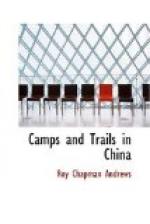The traps were set under logs and stumps and in the grass where we found the “runways” or paths which mice, rats and voles often make. These animals begin to move about just after dark, and we usually would inspect our traps with a lantern about nine o’clock in the evening. This not only gave the trap a double chance to be filled but we also secured perfect specimens, for such species as mice and shrews are cannibalistic, and almost every night, if the specimens were not taken out early in the evening, several would be partly eaten.
Small mammals are often of much greater interest and importance scientifically than large ones, for, especially among the Insectivores, there are many primitive forms which are apparently of ancestral stock and throw light on the evolutionary history of other living groups.
Li-chiang is a fur market of considerable importance for the Tibetans bring down vast quantities of skins for sale and trade. Lambs, goats, foxes, cats, civets, pandas, and flying squirrels hang in the shops and there are dozens of fur dressers who do really excellent tanning.
This city is a most interesting place especially on market day, for its inhabitants represent many different tribes with but comparatively few Chinese. By far the greatest percentage of natives are the Mosos who are semi-Tibetan in their life and customs. They were originally an independent race who ruled a considerable part of northern Yuen-nan, and Li-chiang was their ancient capital. To the effeminate and “highly civilized” Chinese they are “barbarians,” but we found them to be simple, honest and wholly delightful people. Many of those whom we met later had never seen a white woman, and yet their inherent decency was in the greatest contrast to that of the Chinese who consider themselves so immeasurably their superior.
The Mosos have large herds of sheep and cattle, and this is the one place in the Orient except in large cities along the coast, where we could obtain fresh milk and butter. As with the Tibetans, buttered tea and tsamba (parched oatmeal) are the great essentials, but they also grow quantities of delicious vegetables and fruit. Buttered tea is prepared by churning fresh butter into hot tea until the two have become well mixed. It is then thickened with finely ground tsamba until a ball is formed which is eaten with the fingers. The combination is distinctly good when the ingredients are fresh, but if the butter happens to be rancid the less said of it the better.
The natives of this region are largely agriculturists and raise great quantities of squash, turnips, carrots, cabbage, potatoes, onions, corn, peas, beans, oranges, pears, persimmons and nuts. While traveling we filled our saddle pockets with pears and English walnuts or chestnuts and could replenish our stock at almost any village along the road.
Everything was absurdly cheap. Eggs were usually about eight cents (Mexican) a dozen, and we could always purchase a chicken for an empty tin can, or two for a bottle. In fact, the latter was the greatest desideratum and when offers of money failed to induce a native to pose for the camera a bottle nearly always would decide matters in our favor.




